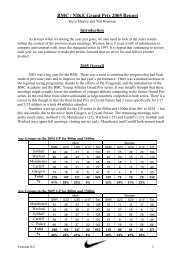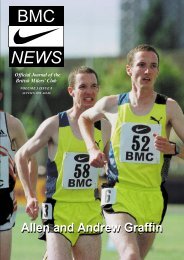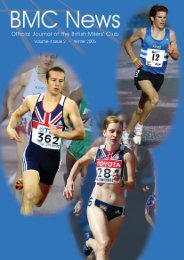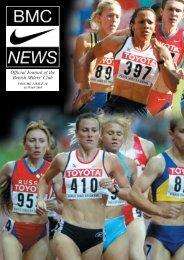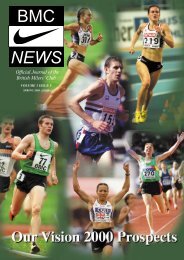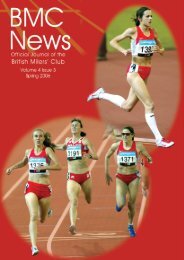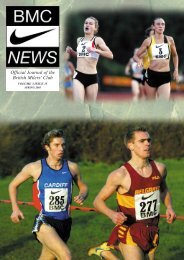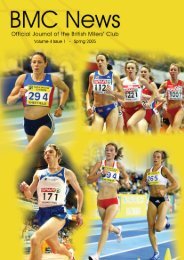Autumn 2007 - British Milers Club
Autumn 2007 - British Milers Club
Autumn 2007 - British Milers Club
- No tags were found...
You also want an ePaper? Increase the reach of your titles
YUMPU automatically turns print PDFs into web optimized ePapers that Google loves.
usually be successful. Accidentalbumping and tripping are part andparcel of indoor running anddisqualifications are not uncommon.1500m TacticsAs you will see as I go through thetactical scenarios of each event that thelonger the distance competed over, theimportance of being in immediatecontact with the leaders has lesserimportance, but tactical awareness isvital to success no matter what distanceis run.As the 1500m is the first middledistance event to start on a curved line,close contact is inevitable in the first100m of the race. Many athletes willinvariably target the inside lane asquickly as possible, but in a fast race inparticular, athletes would be betteradvised to run the shortest distancepossible to the first bend and thensettle into the position that isappropriate to their plan.Energy conservation is important in the1500m and those that have adequateenergy supplies left for the last lapusually have a good chance of attainingtheir goals.Concentration is important in the1500m and the number of competitorsin a race will usually be 12, althoughsome invitational events will fit in manymore. If the field is strung out, thedistance between first and last can bemuch larger than in an 800m race andalthough the pace is generally slower,the gap cannot be allowed to get toobig if a strike for home is planned withmuch ‘traffic’ to negotiate to hit thefront.Some races over the years such as theEuropa Cup have producedunbelievably slow paces for three lapsbefore ending up as a 400m sprint.Other races like the 1974Commonwealth Games where FilbertBayi set an incredible pace over thefirst two laps which hadn’t been seenbefore seemed foolish, but he prevailedand with a world record! Athletes likeSteve Cram regularly upped the pacesignificantly over the final 500m-600mwith great success. Current worldrecord holder Hicham El Guerrouj hasthe innate ability to subtly increase thepace over the final 600m-800m in away that is energy efficient but alsodamaging to his opponents. KellyHolmes’ Athens Olympic winning runreplicated her 800m tactics, staying atthe back and covering any moves whennecessary, what it did allow her to dowas conserve energy for her final surgeover the final 150m. Athletes like RiuSilva and Fermin Cacho are noted‘kickers’ and like to follow and finishvery quickly and have been verysuccessful with those tactics at thehighest levels.In the 800m you probably aren’tallowed any tactical errors with so littletime to respond, but perhaps the1500m allows for some minorindiscretions with more time to react tothese providing the athlete has thephysical attributes to react to thesituation at the time. Most situationsrequire a ‘cool-head’ and those thatpanic usually end up at the back of thefield and theonly way oflearning how tohandle these isthrough practiceand experience.Pace distributionis thereforecrucial to theexecution of anyrace andunnecessaryincreases intempo early ormid-race willhave adverseeffects withanaerobicdeficiencies andlactateaccumulation which needs to bereserved for the end of the race.Indoor races over 7½ laps need muchconcentration and a fixation on wherethe athlete wants and needs to be inthe competition. If most of the fieldtends to pick up the pace outdoors with400m remaining then indoors this willbe with 2 laps to go and this can bepsychologically difficult with thejudgement of effort different as therewill be 4 straights and 4 bends tonegotiate. Pace distribution should beeasier however with times being givenevery 200m as opposed to 400moutdoors.5000m/10000mThese events are now becoming someof the hardest to be successful at due tothe awesome performances of theAfrican athletes at the highest level.They are almost turning out to be 11½and 24 laps of hard running and then a400m at break-neck speed and thatgoes for both male and female races.These races require great concentrationlevels no matter what level the athleteis at. It is amazing how many athletescan run good 5k and 10k races atcross country and on the roads but20 BMC News : <strong>Autumn</strong> <strong>2007</strong>



